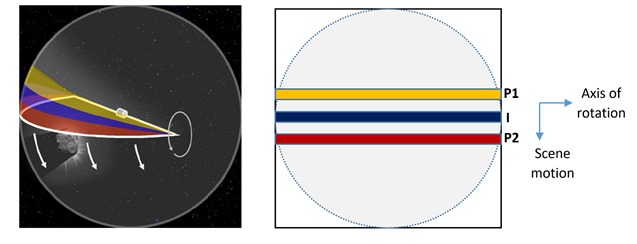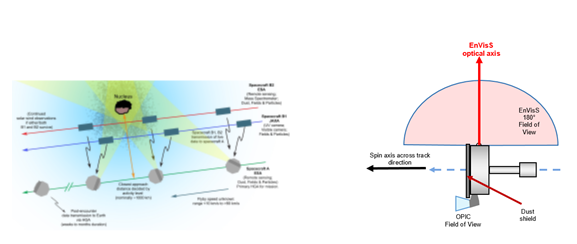The Entire Visible Sky (EnVisS) imager for the Comet Interceptor ESA mission
- 1CNR-IFN Padova, Padova, Italy (vania.dadeppo@pd.ifn.cnr.it)
- 2INAF-IAPS, Roma, Italy
- 3INAF-OAPd, Padova, Italy
- 4CSIC-IAA, Granada, Spain
- 5Aalto University, Espoo, Finland
- *A full list of authors appears at the end of the abstract
Abstract
Comet Interceptor is a Fast mission of the European Space Agency (ESA) conceived to study a long period comet.
The mission concept includes a spinning probe venturing very near to the comet; on this probe, the Entire Visible Sky (EnVisS) camera will be mounted.
EnVisS is an intensity and polarimetric imager that will address several fields of cometary science by carrying out observations close to, and within a comet’s coma.
In this work, the instrument concept, design and scientific capabilities of EnVisS will be presented.
1. Introduction
The present Comet Interceptor mission configuration comprises a spacecraft and two probes. The spacecraft, called A, will make remote and in-situ observation of the target from afar. While the two probes, one provided by the Japan Aerospace Space Agency JAXA, called B1, and the other one provided by ESA, called B2, will venture near to the target performing a fly-by [1].
The B2 probe will be a spinning spacecraft, thus a rotational push-broom or push-frame imaging technique can be adopted for EnVisS to scan and image the whole scene around the spacecraft. Filtering strips mounted very near to the detector can be foreseen for studying the target in different wavelength ranges and performing polarimetric imaging.
EnVisS will map the intensity and the degree of linear polarization and polarization angle orientation of the light scattered by the dust particles in the comet coma with a full 180° phase angle coverage. The linear polarization depends on dust size distribution, morphology, porosity and composition [2]. The monitoring of linear polarization will provide some clues on how these parameters correlate.
2. Instrument acquisition concept
The EnVisS instrument has been conceived to work in the visible wavelength range from 550-800 nm. The extremely wide FoV of the instrument is designed to acquire the full sky.
EnVisS will feature a flexible push-broom/push-frame imaging technique, while the probe rotates (see Figure 1) slices of the sky are acquired that will be later stitched together on-ground to form a full sky image.

(a) (b)
Figure 1: In (a) illustration of EnVisS full-sky imaging scanning concept. In (b) schematics of the filters strips images on the 2kx2k detector.
The probe spin-axis will be pointing to the comet nucleus for most of the time, except at the closest approach when the comet nucleus will fall inside the camera FoV (see Figure 2 for the expected geometry of the fly-by and the EnVisS placement on the B2 probe).

(a) (b)
Figure 2: In (a) expected B2 comet fly-by geometry in (b) placement of the EnVisS camera on the B2 probe.
3. EnVisS: Instrument Design
The EnVisS instrument is composed of different parts:
- a fish-eye lens, under study at the Leonardo S.p.A. company in Florence (IT);
- a commercial space-qualified detector from 3D-Plus [3], that will be equipped with a filter strip package;
- ad-hoc power and data handling units;
- software.
The design solution adopted for the filters in EnVisS allows for a compact, low mass and low complexity camera and avoids the use of a filter wheel. Each filter strip is covering a different area on the detector.
Three broad-band filters, all working in the same wavelength range, are foreseen for the camera:
- one broadband intensity filter positioned to be centered on the detector (see Figure 1b blue central strip I);
- two polarimetric filters with transmission axis angles oriented at 45° one to the other (see Figure 1b the red and yellow strips P1 and P2).
The EnVisS optical head will have a 3.45 mm focal length with an MTF of 70% at 45 lp/mm to match a 2x2 pixel resolution element. The full FoV of the instrument will be 180° in the direction of the spin axis, i.e. across-track direction, and 45° in the plane of rotation and motion of the scene, i.e. along-track direction. The full EnVisS characteristics are summarized in Table 1.
|
Wavelength coverage |
550-800 nm 1 broad band filter (I) and 2 polarimetric filters (P) |
|
Instrument FoV |
180°x45° (fixed full instrument instantaneous) 180°x360° (dynamic after image reconstruction) 180°x2° (instantaneous per each filter strip) |
|
Entrance aperture (F#) |
1.23 mm (2.8) |
|
Detector |
CMOS 2kx2k 5.5 micron px size |
|
Scale factor |
0.1°/px |
|
MTF |
>70% @ 45 lp/mm |
|
Distortion and telecentricity |
< 8% (f-theta distortion law) and <4° (at the FoV edges) |
Table 1 Summary of EnVisS characteristics
The direction of apparent motion of the scene due to the S/C B2 rotation, i.e. along-track direction, is parallel to the vertical direction in Figure 1 b, while the horizontal direction, corresponds to the direction of the spin axis.
A flexible approach has been devised to allow obtaining the required SNR of 10 for the broadband images and 100 for each polarimetric image. Depending on the target object activity, the map of the coma will be taken with different spatial resolution, i.e. smearing and pixel binning.
Along track, the signal from the coma is not expected to change too much, high spatial resolution is not required and smearing can be tolerated. The spatial resolution is retained in the across-track direction and assures a sampling of the comet phase function every 0.2°. This strategy will also allow for an adjustment of the exposure time if the radiance of the coma is different from expected.
Further pixel binning on-board, or co-adding, on-ground, of the images over different rotations, could be considered if the signal happens to be extremely low.
Acknowledgements
This work has been supported by the Italian Space Agency (ASI) through a contract to the Istituto Nazionale di Astrofisica (2020-4-HH.0) and by the State Agency for Research of the Spanish MCIU through the ‘Center of Excellence Severo Ochoa” award to the Instituto de Astrofısica de Andalucıa (SEV-2017-0709) and from project PGC2018-099425-B-I00 (MCI/AEI/FEDER, UE).
References
[1] Snodgrass, C. and Jones, G. H., "The European Space Agency’s Comet Interceptor lies in wait", Nat. Commun. 10, 5418 (2019).
[2] Fulle, M., Levasseur-Regourd, A. C., McBride, N. and Hadamcik, E., "In situ dust measurements from within the coma of 1P/Halley, The Astronomical Journal, 119:1968-1977 (2000).
[3] https://www.3d-plus.com/
Geraint Jones (6,7), Giuseppe Impiccichè (8,9), Paolo Chioetto (1,10), Lorenzo Cocola (1), Fabio Frassetto (1), Ivano Bertini (9), Marco Fulle (11), Cecilia Tubiana (2), Alessandra Rotundi (9), Juan-Carlos Gomez (4), Daniel Guirado (4), Pedro J. Gutierrez (4), Fernando Moreno (4), Olga Muñoz (4) [Additional affiliations: (6) UCL-MSSL, Dorking, UK;(7)The Centre for Planetary Sciences at UCL/Birkbeck, London, UK (8) Leonardo SpA, Campi Bisenzio (FI), Italy; (9) University of Naples Parthenope, Napoli, Italy; (10) CISAS, University of Padova, Padova, Italy; (11) INAF-OATs, Trieste, Italy]
How to cite: Da Deppo, V., Della Corte, V., Zuppella, P., Nordera, S., Pernechele, C., Lara, L. M., Castro, J. M., Jiménez, J., Martinez, I., and Praks, J. and the EnVisS Team: The Entire Visible Sky (EnVisS) imager for the Comet Interceptor ESA mission, Europlanet Science Congress 2022, Granada, Spain, 18–23 Sep 2022, EPSC2022-273, https://doi.org/10.5194/epsc2022-273, 2022.

